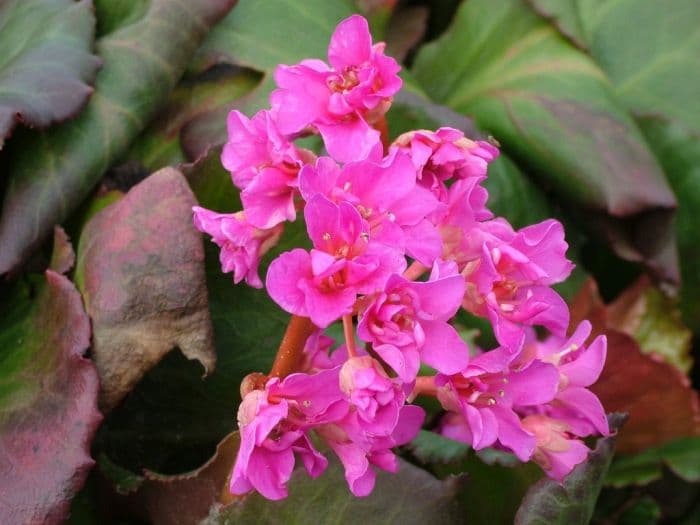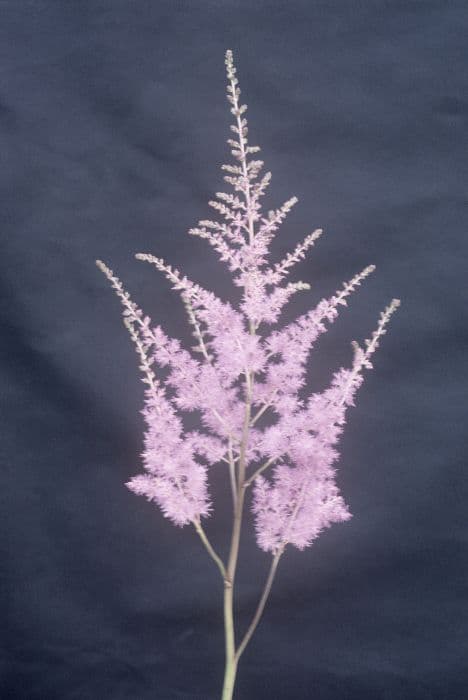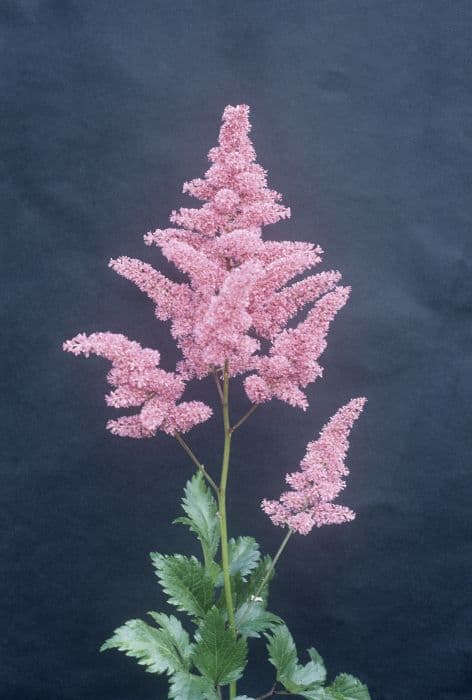Elephant's ears Bergenia 'Abendglut'

ABOUT
Bergenia 'Abendglut', commonly known as Siberian Tea, is a striking perennial that boasts a robust and lush appearance. This plant presents leathery, deep green leaves that have a glossy surface and are quite large, with a rounded, heart-shaped outline. These leaves are evergreen, providing year-round interest, and often turn attractive shades of reddish-bronze or purple during the colder months, adding a splash of color to the garden when many other plants have faded. The blooms of Siberian Tea are equally impressive, with dense clusters of deep pink to magenta flowers that rise above the foliage on sturdy, reddish stems. These flowers have a bell-shaped form, and each individual bloom is small but collectively they make a striking display that can catch the eye from a distance. The flowering period typically occurs in late winter to early spring, bringing some of the first signs of life to the garden after the winter chill. Siberian Tea has a clumping habit, with the leaves forming a low mound, from which the floral spikes emerge. The plant presents a rich texture owing to its leaf shape and size, creating a visual interest that complements both lush and more minimalist garden designs. Its bold leaves and vibrant flowers work well in mass plantings, as ground cover, or even in borders where its striking appearance can be appreciated up close.
About this plant
 Names
NamesFamily
Saxifragaceae
Synonyms
Evening Glow Bergenia, Abendglut Saxifrage, Abendglut Bergenia
Common names
Bergenia 'Abendglut'
 Toxicity
ToxicityTo humans
Bergenia 'Abendglut', commonly known as Bergenia, is not widely recognized for being toxic to humans. There is limited information indicating any significant toxic properties. However, as with many plants, it is possible for individuals to experience some form of discomfort or allergic reaction if Bergenia is ingested or handled, although this is uncommon. If a person does experience symptoms after ingesting Bergenia, it would be prudent to consult a medical professional.
To pets
Bergenia, commonly known as Bergenia, is not generally considered highly toxic to pets. However, it is always best to prevent pets from ingesting plants, as individual animals might have sensitivities or allergic reactions. If a pet does consume parts of a Bergenia plant and exhibits unusual symptoms, one should contact a veterinarian. Common signs of plant toxicity in pets can include vomiting, diarrhea, or lethargy, although specific symptoms related to Bergenia are not widely documented.
 Characteristics
CharacteristicsLife cycle
Perennials
Foliage type
Evergreen
Color of leaves
Green
Flower color
Pink
Height
1 foot (30 cm)
Spread
2 feet (60 cm)
Plant type
Herb
Hardiness zones
3
Native area
Asia
Benefits
 General Benefits
General Benefits- Attractive Foliage: Bergenia 'Abendglut', commonly known as 'Evening Glow' Bergenia, has broad, glossy evergreen leaves that provide year-round interest.
- Seasonal Flowers: It produces deep pink to red flowers in the spring, which can add a splash of color to gardens during early growing seasons.
- Drought Resistance: Once established, it is quite tolerant of drought conditions, making it suitable for xeriscaping or low-water gardens.
- Easy to Grow: 'Evening Glow' Bergenia is considered low-maintenance and is easy to grow, requiring minimal care once established.
- Cold Hardy: It is capable of withstanding colder temperatures, making it a good choice for gardens in a variety of climates.
- Pest Resistant: The plant is generally resistant to pests, reducing the need for chemical treatments.
- Shade Tolerant: It can grow in a range of light conditions, including partial to full shade, providing flexibility in garden design.
- Ground Cover: Its clumping habit makes it an excellent ground cover, helping to suppress weeds and reduce soil erosion.
- Edging Plant: The compact growth habit of Bergenia 'Abendglut' makes it suitable for borders or edging in garden beds.
 Medical Properties
Medical Properties- This plant is not used for medical purposes.
 Air-purifying Qualities
Air-purifying QualitiesThis plant is not specifically known for air purifying qualities.
 Other Uses
Other Uses- Bergenia 'Abendglut', commonly known as Elephant's Ears, can be used as a natural dye for fabrics, providing a range of colors from greens to browns depending on the mordant used.
- Elephant's Ears leaves are sometimes implemented in crafts, such as leaf printing, to create unique patterns and designs on paper or cloth.
- The tough, leathery leaves of Elephant's Ears can be used as impromptu scraps for cleaning or polishing hard surfaces when in a pinch.
- The plant is often used in winter gardens for its persistent leaves that provide a touch of green during bleak months.
- Elephant's Ears can be planted as a living mulch, as they form dense clumps which can help retain soil moisture and suppress weeds.
- The plant's foliage can be used in floral arrangements, especially in the winter, to add fullness and a unique texture to bouquets.
- In frost-prone areas, the evergreen leaves of Elephant's Ears can serve as a frost protectant cover for more sensitive ground-dwelling flora.
- Garden designers sometimes use Bergenia 'Abendglut' to create a contrasting backdrop for displaying sculptures and other garden features.
- Elephant's Ears can be used in sensory gardens, as their large leaves are pleasing to touch, with a distinctive smooth and waxy texture.
- In large quantities, the clumps of Elephant's Ears are sometimes used as a sound barrier, reducing noise pollution in tranquil garden spots.
Interesting Facts
 Feng Shui
Feng ShuiThe Bergenia is not used in Feng Shui practice.
 Zodiac Sign Compitability
Zodiac Sign CompitabilityThe Bergenia is not used in astrology practice.
 Plant Symbolism
Plant Symbolism- Endurance: Bergenia, or Elephant's Ears, is known for its tough, leathery leaves that persevere through harsh weather, symbolizing the ability to endure and withstand challenges.
- Protection: The robust nature of Elephant's Ears gives it a protective quality, representing safeguarding and shelter.
- Adaptability: Given Elephant's Ears's flexibility to thrive in a variety of conditions, this plant symbolizes the ability to adapt to changing environments.
- Longevity: With its perennial growth habit, Elephant's Ears signify long life and resilience over time.
 Water
WaterElephant's Ears should be watered regularly to keep the soil evenly moist but not waterlogged. During the growing season, typically from spring to fall, it's ideal to water them once a week, giving them about 1 to 1.5 gallons depending on the size of the plant and the environmental conditions. In the winter, reduce the watering to every other week, ensuring the top inch of soil has dried out before adding more water. Always avoid letting the plant sit in standing water as this can lead to root rot.
 Light
LightElephant's Ears prefers partial shade to full shade, thriving in a location that receives filtered sunlight or morning sun followed by afternoon shade. Direct, harsh sunlight can scorch the leaves, so a spot beneath a canopy of trees or on the north side of a building is often ideal for this plant.
 Temperature
TemperatureElephant's Ears favors temperatures between 60°F and 75°F for optimal growth. While it can tolerate occasional dips in temperature down to about 20°F, frost can damage the leaves. It's best to protect the plant during extreme temperatures below freezing to ensure its survival and health.
 Pruning
PruningElephant's Ears requires minimal pruning, primarily to remove any damaged or yellowing leaves to maintain the plant's appearance and health. The best time to prune is in the spring before new growth starts so that energy can be directed to fresh leaves. Pruning can be done as needed throughout the year to remove occasional spent leaves.
 Cleaning
CleaningAs needed
 Soil
SoilElephant's Ears 'Abendglut' prefers moist, but well-drained, fertile soil with high organic content. A mix of two parts garden soil to one part peat and one part perlite or sand would be ideal. The soil pH should lean toward slightly acidic to neutral, ranging between 5.5 and 7.
 Repotting
RepottingElephant's Ears 'Abendglut' does not need to be repotted often, typically once every 3-4 years. You should repot when it outgrows its current container or when the soil becomes compacted and is no longer draining well.
 Humidity & Misting
Humidity & MistingElephant's Ears 'Abendglut' is relatively tolerant of different humidity levels but thrives best in moderate to high humidity. It is adapted to outdoor conditions so usually does not require additional indoor humidity control.
 Suitable locations
Suitable locationsIndoor
Place Elephant's Ears in well-lit area avoiding direct sun. Water when topsoil dries.
Outdoor
Plant in partial shade with moist, well-drained soil.
Hardiness zone
Elephant's Ears 'Abendglut' is suitable for 3-8 USDA hardiness zones.
 Life cycle
Life cycleBergenia 'Abendglut', commonly known as Evening Glow Bergenia, begins its life cycle as a seed, which upon germination, develops into a young seedling with a basic root system and juvenile leaves. As it matures into the vegetative growth stage, the plant forms a rosette of large, leathery, deep green leaves. During the flowering stage, usually in early spring, it produces pink to dark magenta flowers atop thick, reddish stems that can persist through the season. After pollination, the flowers develop into capsules containing seeds, completing the reproductive cycle. As a perennial, Bergenia 'Abendglut' enters a period of dormancy in the winter, with foliage often turning purplish-bronze, and then it resumes growth from its rhizomes the following spring. Over time, the clumps of Bergenia can become dense and may require division to maintain plant vigor and rejuvenate growth.
 Propogation
PropogationPropogation time
Spring-Early Summer
Propogation: Bergenia 'Abendglut', commonly known as Evening Glow Bergenia, is typically propagated by division. The best time to propagate by division is in the spring, just as the plant emerges from dormancy, or in early fall to give the new divisions time to establish before the winter. To do this, carefully dig up the clump and use a sharp knife or spade to divide the plant into smaller sections, making sure that each new section has a portion of the root system attached. Replant the divisions at the same depth they were growing before and water well. New plants should be spaced about 12 inches (roughly 30 centimeters) apart to allow sufficient room for growth. This method is popular because it is simple, effective, and helps to rejuvenate older clumps that may have become woody and less floriferous over time.









